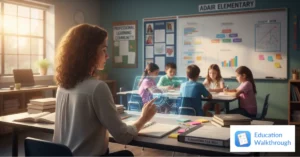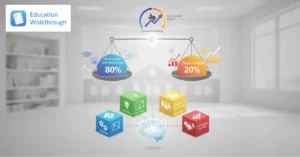The classroom environment is a dynamic and complex space where learning and teaching processes occur. It is a place where students and teachers interact, where knowledge is shared, and where skills are developed. The classroom environment is not just a physical space but also a psychological and social space that influences the learning and teaching processes.
A classroom walkthrough is a strategy used by educators to observe and gather data about the teaching and learning process in the classroom. It is a powerful tool for improving the quality of education and enhancing student learning outcomes. This article will provide a comprehensive explanation of the classroom walkthrough, its purpose, process, benefits, and challenges.
What is a Classroom Walkthrough?
A classroom walkthrough is a brief, non-evaluative observation of classroom instruction that provides insight into student learning and teacher instruction. It is a form of formative assessment for teachers, providing them with feedback on their teaching practices and strategies.
Walkthroughs are typically conducted by school administrators or instructional coaches, but can also be done by peer teachers. The observer walks through the classroom, taking note of the teaching methods, student engagement, classroom management, and the overall learning environment.
Types of Classroom Walkthroughs
There are several types of classroom walkthroughs, each with its unique focus and purpose. The most common types include instructional walkthroughs, safety walkthroughs, and technology walkthroughs.
Instructional walkthroughs focus on the teaching strategies and methods used by the teacher. Safety walkthroughs focus on the physical safety of the classroom environment, while technology walkthroughs focus on the use of technology in teaching and learning.
Purpose of Classroom Walkthroughs
The primary purpose of a classroom walkthrough is to improve the quality of instruction and enhance student learning outcomes. It provides teachers with constructive feedback on their teaching practices, helping them to reflect on their instruction and make necessary improvements.
Walkthroughs also serve to promote a culture of continuous learning and improvement among teachers. They foster open communication and collaboration among teachers and administrators, promoting a shared vision for quality instruction.
The Classroom Walkthrough Process
The classroom walkthrough process involves several steps, including planning, observation, feedback, reflection, and action. Each step is crucial to the success of the walkthrough and contributes to its overall effectiveness.
The planning stage involves determining the focus of the walkthrough, setting the observation schedule, and communicating the plan to the teachers. The observation stage involves the actual walkthrough of the classroom, where the observer takes note of the teaching and learning process.
Feedback and Reflection
After the observation, the observer provides feedback to the teacher. This feedback should be constructive, specific, and focused on the agreed-upon focus of the walkthrough. It should highlight the strengths of the teacher’s instruction and suggest areas for improvement.
The reflection stage involves the teacher reflecting on the feedback received and considering how to incorporate the suggestions into their teaching practice. This stage is crucial for the teacher’s professional growth and development.
Action and Follow-up
The action stage involves the teacher implementing the suggestions from the feedback into their teaching practice. This may involve making changes to their teaching strategies, classroom management techniques, or use of technology.
The follow-up stage involves a subsequent walkthrough to assess the effectiveness of the changes made. This provides an opportunity for further feedback and reflection, ensuring continuous improvement in teaching practice.
Benefits of Classroom Walkthroughs
Classroom walkthroughs offer numerous benefits for teachers, students, and school administrators. For teachers, walkthroughs provide valuable feedback on their teaching practice, helping them to improve their instruction and enhance student learning outcomes.
For students, walkthroughs contribute to a better learning environment, as teachers are able to adjust their teaching strategies and techniques based on the feedback received. This leads to more effective instruction and improved student learning.
Benefits for School Administrators
For school administrators, walkthroughs provide a practical and efficient way to monitor the teaching and learning process in the classroom. They provide insight into the instructional practices of teachers, helping administrators to make informed decisions about professional development and resource allocation.
Walkthroughs also promote a culture of continuous learning and improvement among teachers, fostering a collaborative and supportive school environment.
Challenges of Classroom Walkthroughs
Despite their benefits, classroom walkthroughs also pose several challenges. One of the main challenges is the potential for walkthroughs to be perceived as evaluative rather than formative. This can create a sense of fear and resistance among teachers, hindering the effectiveness of the walkthrough.
Another challenge is the time and resource commitment required for effective walkthroughs. Conducting regular walkthroughs requires a significant amount of time and effort from school administrators or instructional coaches.
Overcoming the Challenges
There are several strategies that can be used to overcome the challenges of classroom walkthroughs. One of the most effective strategies is to ensure that the walkthrough process is transparent and collaborative. This involves clearly communicating the purpose and process of the walkthrough to the teachers and involving them in the planning and feedback stages.
Another strategy is to provide training for the observers to ensure that they are able to effectively observe and provide constructive feedback. This can help to increase the credibility and acceptance of the walkthrough process among teachers.
Conclusion
In conclusion, a classroom walkthrough is a powerful tool for improving the quality of instruction and enhancing student learning outcomes. It provides valuable feedback for teachers, promotes a culture of continuous learning and improvement, and provides insight into the teaching and learning process for school administrators.
Despite the challenges, with careful planning and implementation, classroom walkthroughs can be an effective strategy for enhancing the quality of education and fostering a supportive and collaborative school environment.





